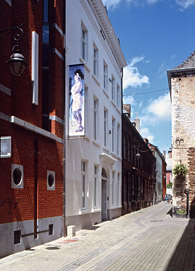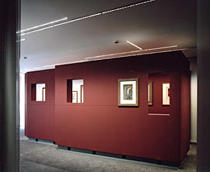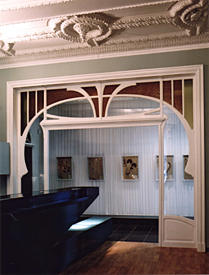

|
|

|
|
The Félicien Rops Museum is located in a brick and blue stone building, a former hotel de maitre (period house), which dates from the first half of the 18th century. The building underwent extensive renovations in the19th century including the addition of a storey and new windows. From 1834 to 1866 it belonged to Félicien Rops’ parents-in-law, the Polet de Faveaux family. The museum is located at the heart of the old part of Namur, not far from the birthplace of the artist.
|
|
|
|


|
Currently the museum houses a collection of over 3000 works by Félicien Rops. The governing idea of the actual tour of the museum is discovery through separate areas, as opposed to a direct and all-encompassing view of the Rops’ work.
This idea is immediately confirmed when we arrive at the museum, in front of the very differentiated façades of the old and new building: one, repainted in a light colour after the manner of the façades of its period, the other, in a contemporary style, retaining its redbrick surface.
The entrance hall leads visitors directly to the reception room rather than drawing their eyes, as it previously did, to the opening leading out into the garden. In actual fact, the entrance hall has been made opaque, allowing only the light to filter through. In this way, the discovery of the garden (which is also scheduled to be renovated), and the sculptures planned to be installed in the garden will be deferred till later on.
In the same spirit, several fixed windows placed in the entrance hall look onto the interior of the library.
Upstairs too, openings, “gaze boxes” give a hint of the rooms to be discovered or provide a glimpse of those you have just left.
These specific atmospheres are also created by the arrangement of veils spread along the outer walls, which are stretched or tightened behind the pictures, so producing an effect that creates and varies the gaps according to the themes of the works.
Showcases and drawers, desks, recesses, arranged in all the rooms, also allow the visitor to take a more curious, more precise and probably a more in-depth look at a set of etchings, letters, annotations, etc. which ask for nothing better than to be discovered. While, on the uppermost floor of the museum, the space opens out and the presentation becomes more airy.
Lastly, during the actual tour, visitors “mark time” before discovering the artist’s most notorious works: Pornokratès toys with their patience …
The tour begins with a biographical presentation of the artist, in connection with the artistic and political events of the period; the first galleries are logically devoted to Rops’ first artistic sallies, his life in Brussels, his significant artistic encounters in Belgium, the period of realism ...
The “Parisian Rops” comes next as the artist’s talent blossoms through his drawings and paintings of nightlife (Le Bouge à Matelots, la Dèche, la Buveuse d’Absinthe, the “Dame au Pantin” …).
A room is specially devoted to his etchings and highlights the Museum’s collection, enhanced with educational showcases together with a video screen showing the various etching techniques, tools and processes.
There is also the opportunity to discover the works of distraction, connected with Rops’ journeys and the places where he stayed, as well as the artist’s close relationships with the literary world of his time though his work as an illustrator and also through his prolific correspondence. Not forgetting, of course, the satanic and erotic works; they too have their own separate room.
|
Text: B. Bonnier, N. Malinconi, V. Carpiaux - Information
Translation: Caroline McLoughlin
Design and Production:
Infographie-Ciger s.a.
Copyright © ciGersoft 1995-1998 - All Rights Reserved.
|
|


